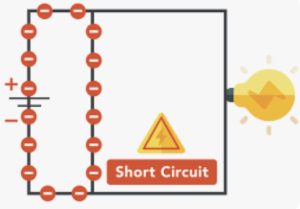A short circuit is a common electrical malfunction that occurs when current flows along an unintended path with little to no resistance. This bypasses the normal load (e.g., a light bulb or appliance), leading to excessive current flow, overheating, and potential hazards like fires or equipment damage. This article explores the science behind short circuits, their causes, consequences, and preventive measures.
How Electrical Circuits Work
In a typical circuit, electricity flows from a power source (e.g., a battery or outlet) through a conductor (wire) to a load (device), and returns to the source. The load provides resistance, which limits current flow to safe levels. Ohm’s Law (V = IR) governs this relationship:
Voltage (V) drives the current.
Resistance (R) restricts it.
Current (I) increases if resistance drops.
In a short circuit, the load is bypassed, reducing resistance drastically. This causes current to surge, generating heat and potentially damaging the system.
Causes of Short Circuits
1. Damaged Insulation
Electrical wires are coated with insulating materials (e.g., PVC) to prevent contact between conductors. Insulation can degrade due to:
Aging: Brittle insulation in old wiring.
Physical Damage: Rodents chewing wires, nails puncturing cables during construction, or abrasion from sharp objects.
Heat: Overloaded circuits melting insulation.
Example: Exposed live and neutral wires touching in a frayed power cord creates a direct path for current.
2. Faulty Appliance Wiring
Internal defects in devices, such as loose connections or worn-out components, can cause shorts.
Frayed Cords: Repeated bending damages insulation.
Loose Terminals: Wires detaching and contacting other parts.
3. Improper Installation
DIY errors or unprofessional work can lead to:
Incorrect Wiring: Live and neutral wires connected improperly.
Loose Connections: Wires in outlets or junction boxes touching unintentionally.
4. Conductive Material Ingress
Water, dust, or metal debris (e.g., paperclips) bridging conductors.
Water Exposure: Spills or flooding in outlets or appliances.
Humidity: Moisture buildup corroding components.
5. Overloading Circuits
Plugging too many devices into a single circuit causes overheating, melting insulation, and shorts.
6. Environmental Factors
Corrosion: Degrades connections, increasing resistance and heat.
Voltage Spikes: Lightning strikes or power surges breaking down insulation.
7. Manufacturing Defects
Poorly designed or assembled components (e.g., batteries with internal shorts).
Types of Short Circuits
Normal Short Circuit: Direct contact between live and neutral wires.
Ground Fault: Current flows to the ground (common in wet environments).
Consequences of Short Circuits
Fire Hazards: Overheating ignites nearby materials (e.g., insulation, wood).
Equipment Damage: Burnt-out motors, fried circuits.
Electric Shock: Exposed wires energize metal casings.
Power Outages: Tripped breakers or blown fuses disrupt supply.
Arc Flash: High-energy arcs causing explosions (common in industrial settings).
Prevention and Safety Measures
Circuit Protection Devices:
Fuses: Melt to break the circuit during overcurrent.
Circuit Breakers: Automatically trip to halt current flow.
GFCIs (Ground Fault Circuit Interrupters): Detect ground faults in wet areas (e.g., bathrooms).
AFCIs (Arc Fault Circuit Interrupters): Recognize dangerous arc patterns.
Regular Inspections: Check for worn insulation, loose connections, or corrosion.
Proper Load Management: Avoid overloading outlets with power strips.
Environmental Controls: Use waterproof covers outdoors and keep circuits dry.
Quality Components: Adhere to safety standards (e.g., UL certification).
Professional Maintenance: Hire licensed electricians for installations and repairs.
Case Study: The Danger of Overloaded Circuits
A 2019 NFPA report found that 43% of home electrical fires stemmed from short circuits in wiring or lighting. A common scenario involves old wiring in attics overheating due to insulation degradation, igniting nearby flammable materials.
Conclusion
Short circuits pose significant risks but are preventable through understanding their causes and implementing safeguards. Regular inspections, modern protection devices, and adherence to electrical codes are critical. By prioritizing safety, individuals and industries can mitigate the dangers of these unpredictable failures.
- Everything You Need To Know About Limit Switch - May 21, 2025
- Everthing You Should Know About Rheostat - May 20, 2025
- Everything You Need To Know About Reversing Contactor - May 19, 2025







